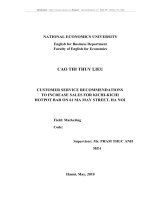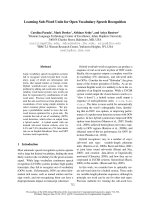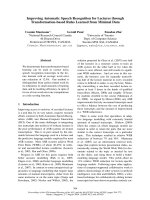Vietnamese speech recognition for customer service call center
Bạn đang xem bản rút gọn của tài liệu. Xem và tải ngay bản đầy đủ của tài liệu tại đây (143.01 KB, 3 trang )
Tuyển tập Hội nghị Khoa học thường niên năm 2018. ISBN: 978-604-82-2548-3
VIETNAMESE SPEECH RECOGNITION
FOR CUSTOMER SERVICE CALL CENTER
Do Van Hai
Faculty of Computer Science and Engineering, Thuyloi University
ABSTRACT
In this paper, we present our effort to build
a Vietnamese speech recognition system for
customer service call center. Various
techniques such as time delay deep neural
network (TDNN), data augmentation are
applied to achieve a low word error rate at
17.44% for this challenging task.
1. INTRODUCTION
Vietnamese is the sole official and the
national language of Vietnam with around 76
million native speakers 1 . It is the first
language of the majority of the Vietnamese
population, as well as a first or second
language for country’s ethnic minority
groups.
At the early time, there were several
attempts to build Vietnamese large
vocabulary continuous speech recognition
(LVCSR) system where most of them
developed on read speech corpuses [1,2]. In
2013, the National Institute of Standards and
Technology, USA (NIST) released the Open
Keyword Search Challenge (Open KWS),
and Vietnamese was chosen as the “surprise
language”. The acoustic data are collected
from various real noisy scenes and telephony
conditions. Many research groups around the
world have proposed different approaches to
improve performance for both keyword
search and speech recognition [3,4].
In this paper, we present our effort to build
a Vietnamese speech recognition system for
1
/>
customer service call center. After that a text
classifier is place on the top of speech
recognition for phone call classification. The
output of the system is used for customer
service management purposes.
To build a speech recognition system, we
collect 85.8 hours audio data from our call
center. Various techniques are applied such
as time delay neural network (TDNN) [5]
with sequence training, data augmentation
[6], etc. Finally, we achieve 17.44% word
error rate for this challenging task.
The rest of this paper is organized as
follows: Section 2 gives a description of the
proposed system. Section 3 presents
experimental setup and results. We conclude
in Section 4.
2. SYSTEM DESCRIPTION
Figure 1 illustrates the proposed system.
We first build a LVCSR system and then
place a text classifier on the top for phone
call classification. Specifically, audio
waveform from phone calls is first
segmented with a voice activity detector
(VAD). To increase the data quantity, data
augmentation is adopted. Feature extraction
is then applied to use for the acoustic model.
For decoding, acoustic model is used
together with syllable-based language model
and pronunciation
dictionary. After
decoding, recognition output is used to
classify phone calls into different groups. In
the next subsections, the detailed description
of each module is presented.
202
Tuyển tập Hội nghị Khoa học thường niên năm 2018. ISBN: 978-604-82-2548-3
Figure 1. The proposed system f or phone call classification
2.1. Voice activity detection
2.4. Acoustic model
In our call center, the agent channel and
the customer channel are separately recorded.
Hence, there are a lot of silent in each audio
channel and they need to be divided into
short sentence-like segments. In order to
detect voice activity and segment the audio,
we use 10 hours of data to train a VAD
model using GMM model.
Two advanced acoustic models are
considered in this paper i.e., Gaussian
mixture model with speaker adaptive training
[7] (GMM-SAT) and time delay deep neural
network (TDNN) with sequence training [5].
2.5. Pronunciation dictionary
Vietnamese is a monosyllabic tonal
language. Each Vietnamese syllable can be
considered as a combination of initial, final
2.2. Data augmentation
and tone components. Therefore, the lexicon
To build a reasonable acoustic model, need to be molded with tones. We use 47
hundreds to thousands hours of audio are basic phonemes, tonal marks are integrated
needed. However, to achieve transcribed into the last phoneme of syllable to build the
audio data is very costly. To overcome this, pronunciation dictionary for 6k popular
the data augmentation approach is Vietnamese syllables.
considered. It is a common strategy adopted
2.6. Language model
to increase the data quantity to avoid overA syllable-based language model is built
fitting and improve the robustness of the from training transcription. 4-gram language
model against different test conditions. In this model with Kneser-Ney smoothing is used
study, we increase training data size using a after exploring different configuration. We
data augmentation technique called audio also tried to enlarge the text corpus by using
speed perturbation [6]. Speed perturbation different text sources such as from web text
produces a warped time signal, for example, or movie closed caption, however no
given speech waveform signal x(t), time improvement is observed. A possible reason
warping by a factor α will generate signal is that those text sources are too different
x(αt). In this study, we use three different from the customer service domain.
values of α i.e., 0.9, 1.0, 1.1.
2.7. Text classification
After decoding, recognition output is used
for text classification to classify phone calls
We use 40 dimensional Mel-frequency into different groups such as failure report,
cepstral coefficients (MFCCs). Since consultancy services. In this preliminary
Vietnamese is a tonal language, pitch feature study, we simply classify the phone calls
based on a keyword list.
is used to augment MFCC.
2.3. Feature extraction
203
Tuyển tập Hội nghị Khoa học thường niên năm 2018. ISBN: 978-604-82-2548-3
3. EXPERIMENTS
4. CONCLUSION
In this paper, we presented the effort to
develop a Vietnamese speech recognition
We first define the training and the test
system for our phone call classification purpose
sets from the corpus. We extract 19,672 to improve customer service management.
phone calls from 43 agents to form the
Various techniques have been applied to
training set. The training set length is 70 achieve a comparative 17.44% WER.
hours with 125,337 segments. The remaining
set consists of 4,260 phone calls from 7 5. REFERENCES
agents is used for the test set. The test set
duration is 15.8 hours with 28,488 segments. [1] Thang Tat Vu, Dung Tien Nguyen, Mai Chi
Luong, and John-Paul Hosom, “Vietnamese
With this setup, there is no overlapped
large vocabulary continuous speech
speaker between training and the test sets.
recognition,” in Proc. INTERSPEECH, pp.
Performance of all the systems are
492–495, 2005.
evaluated in word error rate (WER).
[2] Tuan Nguyen and Quan Vu, “Advances in
3.1. Experimental setup
3.2. Experimental setup
Table 1 shows WER% of our system with
different types of acoustic model. We can see [3]
that by using TDNN we can get significant
improvement over the traditional GMM
model. In addition, applying data
augmentation, we can reduce error rate
consistently for both the GMM and DNN [4]
acoustic models.
Table 1. Word error rate (% ) of speech
recognition system using GMM and DNN
acoustic models without and with data
augmentation
Acous tic
model
GMM
TDNN
Word Error Rate (%)
[5]
w/o data
with data
augmentation augmentation
28.99
18.04
27.92
17.28
[6]
For analysis, we breakdown performance
of our system for customer and agent sides. [7]
We realize that for agent side, we achieve a
much better performance (WER=10.29%)
than the customer side (WER=26.14). It can
be explained that the speech quality our
customer service staff (agent) is much better
than the customers’ one for example less
noise. In addition, spoken language uttered
by our staff is more formal and hence the
language model is easier to capture it.
204
acous tic modeling for Vietnamese
LVCSR,” in Proc. Asian Language
Proces sing, pp. 280–284, 2009.
Chen, Nancy F., Sunil Sivadas, Boon Pang
Lim, Hoang Gia Ngo, Haihua Xu, Bin Ma,
and Haizhou Li. “Strategies for Vietnamese
keyword search,” in Proc. ICASSP,
pp. 4121-4125, 2014.
Tsakalidis, Stavros, Roger Hsiao, Damianos
Karakos , Tim Ng, Shives h Ranjan,
Guruprasad Saikumar, Le Zhang, Long
Nguyen, Richard Schwartz, and John
Makhoul. “The 2013 BBN Vietnamese
telephone speech keyword spotting system,”
in Proc. ICASSP, pp. 7829-7833, 2014.
Peddinti, Vijayaditya, Daniel Povey, and
Sanjeev Khudanpur, “A time delay neural
network architecture for efficient modeling
of long temporal contexts ,” in Proc.
INTERSPEECH, 2015.
T. Ko, V. Peddinti, D. Povey, S.
Khudanpur, “Audio augmentation for
speech
recognition,”
in
Proc.
INTERSPEECH, 2015.
T. Anastasakos, J. McDonough, and J.
Makhoul, “Speaker adaptive training: a
maximum likelihood approach to speaker
normalization,” in Proc. ICASSP, pp. 10431046, 1997.









